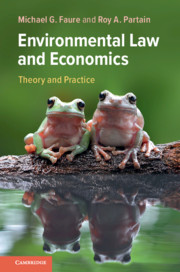Book contents
- Environmental Law and Economics
- Environmental Law and Economics
- Copyright page
- Contents
- Preface
- Acknowledgements
- Abbreviations
- 1 Introduction
- 2 Environmental Harm and Efficiency
- 3 Property Rights Approach to Environmental Law
- 4 Environmental Standard Setting
- 5 Principles of Environmental Law and Environmental Economics
- 6 Pricing Environmental Harm
- 7 Market-Based Instruments
- 8 Liability Rules
- 9 Environmental Regulation
- 10 Environmental Crime
- 11 Insurance for Environmental Damage
- 12 Compensation for Environmental Damage
- 13 Environmental Federalism
- 14 The Role of Environmental Law in Developing Countries
- 15 Epilogue
- References
- Index
6 - Pricing Environmental Harm
Published online by Cambridge University Press: 13 September 2019
- Environmental Law and Economics
- Environmental Law and Economics
- Copyright page
- Contents
- Preface
- Acknowledgements
- Abbreviations
- 1 Introduction
- 2 Environmental Harm and Efficiency
- 3 Property Rights Approach to Environmental Law
- 4 Environmental Standard Setting
- 5 Principles of Environmental Law and Environmental Economics
- 6 Pricing Environmental Harm
- 7 Market-Based Instruments
- 8 Liability Rules
- 9 Environmental Regulation
- 10 Environmental Crime
- 11 Insurance for Environmental Damage
- 12 Compensation for Environmental Damage
- 13 Environmental Federalism
- 14 The Role of Environmental Law in Developing Countries
- 15 Epilogue
- References
- Index
Summary
And to price an aspect of environmental services need not mean a direct 'price to acquire rights to injure' perspective, but rather can reflect the damages imposed on the community from the event of the injury, of the opportunity costs of the events around the environmental injury. Further, there can be a calculation of the costs necessary to completely avoid the events enabling the injury; at what cost can the commercial activity be undertaken in a manner that enables an environment to remain clear of injury. The Baumol-Oates approach, to determine a set of environmental quality standards to facilitate the imposition of marginal cost correcting unit taxes, enables a functional start at implementing a Pigouvian tax system. But no environmental system is simple, the approach will necessarily be limited to an incomplete set of externalities. Under most forms of cost-benefit analysis, the use of marginal costs for environmental losses requires an understanding of the marginal benefits of the activity that caused those injuries, if they are to be aligned for optimal community welfare. However, those costs and benefits may accrue to many diverse stakeholders, present and future, and it may be quite difficult to complete the set of information required to fully implement marginal analysis.
- Type
- Chapter
- Information
- Environmental Law and EconomicsTheory and Practice, pp. 106 - 118Publisher: Cambridge University PressPrint publication year: 2019



